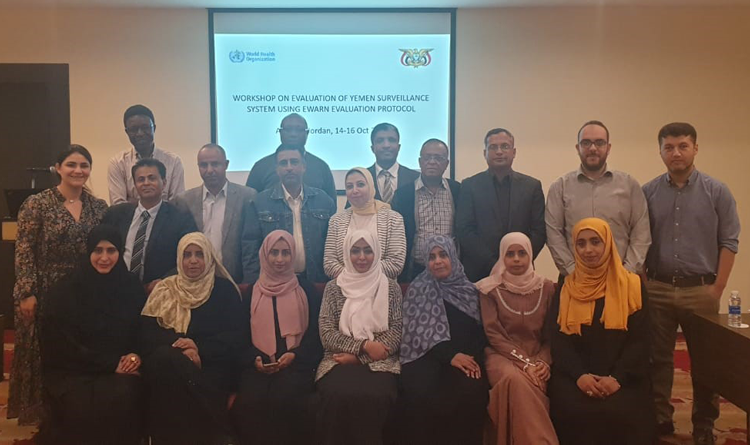 Participants from the Ministry of Public Health in Yemen participated in the workshop. (Photo: WHO)
Participants from the Ministry of Public Health in Yemen participated in the workshop. (Photo: WHO)
The World Health Organization (WHO) in collaboration with the Ministry of Public Health (MoPH) in Yemen organized a workshop to prepare and develop an action plan for the evaluation of the country’s surveillance system which is based on the Early Warning Alert and Response Network (EWARN).
The workshop, which took place on 14-16 October 2019, aimed to train participants on how the EWARN system functions; assess its effectiveness and usefulness to detect, confirm and respond to priority diseases; and provide recommendations and practical measures to improve system performance. The evaluation protocol will assess the functioning of the surveillance system during emergencies, a standard practice for evaluating EWARN as developed jointly between the WHO Eastern Mediterranean Regional Office (EMRO) and the Centers for Diseases Control and Prevention in Atlanta, the United States.
Humanitarian emergencies often increase the risk of transmission for communicable diseases, especially outbreak-prone ones, resulting in an increase in morbidity and deaths. To address this situation and enhance the country’s surveillance capacity to rapidly identify and respond to outbreaks, Yemen’s MoPH in collaboration with WHO implemented EWARN in 2013 under the name of Electronic Disease Early Warning System (eDEWS). This health facility-based surveillance system includes 1990 public and private health facilities located across all the 23 governorates of the country. The paper-based national surveillance system was later integrated with eDEWS to create the eIDEWS to ensure the speedy and efficient collection and analysis of data, and the effective public health response to outbreaks.
The new integrated system now monitors 28 diseases with six being immediately reportable and 22 reportable on a weekly basis. Data is collected from sentinel sites using mobile cellular software before being sent to district, governorate and central surveillance offices. The country is now planning to upgrade and expand the e-surveillance system to include more sentinel sites, but neither the previous national surveillance system nor the current eIDEWS had yet been evaluated. A systematic evaluation was therefore required to ensure that the system was effectively meeting its objectives.
Eight participants from MoHP including the eIDEWS coordinator and focal points at all levels worked intensely during the workshop to develop the evaluation action plan and guiding principles. The workshop developed a detailed evaluation methodology, sample size and sampling mechanism; reviewed and adapted the data collection tools at different levels; and developed a field implementation strategy and road map for the evaluation.
Yemen will now be evaluating its surveillance system to identify technical and operational gaps and work towards the strengthening and enhancement of that system.



